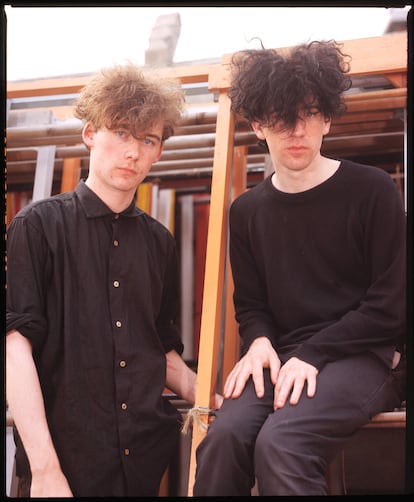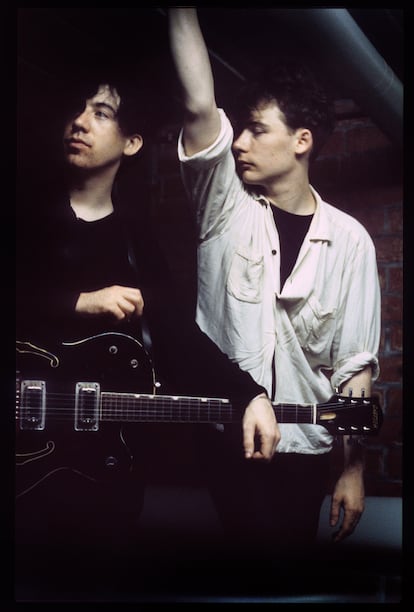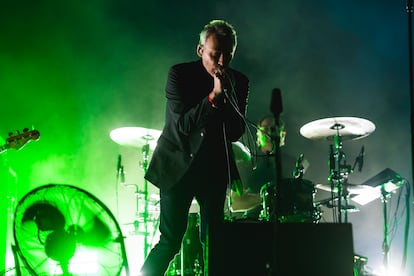The Jesus and Mary Chain, the brothers who hated each other before Oasis
The Scottish band, known for their fighting and chaotic concerts, are now touring the world


With a knack for arriving either too early or too late, the Scottish band The Jesus and Mary Chain picked up the pieces of post-punk in the 1980s. Influencing a handful of bands, they were eventually swept away by the alternative rock boom a decade later. Groups like the Pixies and Sonic Youth, who admired them, managed to define an era with a similar noisy yet melodic formula, while their own record label, Warner, largely scorned their contributions.
There’s something ironic about the fact their oral history book Never Understood coincided with the news of Oasis’s comeback and the on-stage altercation that resulted in the (latest) split of Jane’s Addiction. Brothers Jim, 62, and William Reid, 65, the respective singer and guitarist of The Jesus and Mary Chain, have been part of the scene for much longer. Yet, it seems far fewer people took notice.
In one chapter of Never Understood, which shares its title with one of their songs, William Reid jokes that when Oasis hit it big, it felt as if Liam and Noel Gallagher were the “Hollywood remake of our little indie film about sibling rivalry.” One of the most delightful surprises in the book is that, despite the band’s turbulent history, somber aesthetics, and taciturn demeanor, the Reids possess a remarkable sense of humor. As the only permanent members of the group, they candidly admit they often struggle to remember the names of all the drummers who have come and gone, as the band’s hellish atmosphere burned them out so quickly; in total, they have had 17 former members, including Bobby Gillespie, the frontman of Primal Scream.

Constructed as a dialogue between the singer and guitarist, with the assistance of journalist Ben Thompson, Never Understood offers a generous and light-hearted review of the drama surrounding their relationship. It explores how their shared love for their musical project ultimately triumphed over the intense hatred they developed for each other — a level of animosity that only brothers who are too close can reach.
On September 12, 1998, The Jesus and Mary Chain abruptly ended their 15-year career after a drunken brawl en route to a gig in Los Angeles. The band proceeded with the scheduled performance, which lasted just 15 minutes and featured the singer, under the influence of large quantities of alcohol and cocaine, shouting “bastard!” and “son of a bitch!” at his older brother. In the book, William Reid says that his brother changed after he started using cocaine.
Jim discovered cocaine, he turned into a complete asshole. Nothing stings like what a family member says to you, and I had to go on tour with that son of a bitch,” recalls the guitarist. In 2006, he told The Independent, “After each tour, we wanted to kill each other, and after the final tour, we tried.”
The book reveals that the first outburst between the brothers was sparked by a disagreement over nuts. After a concert, William Reid had a heated argument with his sister-in-law for eating the bowl of nuts, which resulted in the brothers not speaking to each other for three months. However, the conflict had been brewing for quite some time.
In the book, the two agree that drug use played a big role in their fights. William Reid says that he was smoking pot, which made him paranoid, while his brother was using cocaine, which made him aggressive.

“They got on terribly and were on high all day long. I saw them in 1992 at the Universal Sur, a now-defunct venue in Madrid, and they were completely wasted,” recalls journalist Manuel Pinazo, director of Muzikalia. “The concert lasted 40 minutes, and people ended up throwing things on stage and ripping off the curtains.”
As pioneers of the movement later dubbed shoegaze — named for the tendency of musicians to look at their feet while playing due to the plethora of guitar pedal effects — The Jesus and Mary Chain burst onto the scene in 1985 with their seminal album Psychocandy. They released five more albums throughout the 1980s and 1990s, all of which were praised by critics but received scant promotion from Warner, whose executives — caricatured by the Reids in the book as “jackals dressed in Armani” — failed to understand why they buried their compositions in such a sonic storm.
“They did something that nobody else was doing,” says Pinazo. “They were big fans of the more experimental side of The Velvet Underground, of Suicide, and at the same time, of the girl groups of the 1960s or the sound of Phil Spector. People wondered what the hell that was.” Pinazo laments that The Jesus and Mary Chain “did not end up blossoming or developing like other groups,” despite being “very important for many people.”
The crux of the matter lies in the band’s current status; they reunited in 2007 and have remained active without apparent hostilities. The Jesus and Mary Chain released a new album, Glasgow Eyes, last spring and performed in Madrid in May at the Tomavistas festival, where they left a lasting impression. “At over 60 years old, they gave concerts where they sang and sounded better than ever. If they had been more professional back then, they could have possibly achieved something even bigger,” says Pinazo.
Mission: save the music
Jim Reid reflects in the book that a thread ran through the best popular music — citing the blues, Elvis Presley, Bob Dylan, the Beatles and the Rolling Stones, David Bowie and glam, punk and post-punk — but this thread appeared to have been broken. He says that the band hated the music that was topping the charts and wanted to connect back to that thread.
His passionate recounting of how two working-class boys pursued their dream of forming a band is one of the book’s most emotional sections. He describes how they would take photos in their room with a lamp to simulate a concert and feign experience in order to land gigs, and how they celebrated each broadcast of Top of the Pops as a significant event.
The narrative also addresses their reality shocks, such as the realization that they were too introverted for the rock scene — an experience highlighted by the Ramones, who mistakenly believed the Reids hated them after they fell silent in awe when greeted. Or their struggles with mental health: William reveals his long-term battle with depression, while both brothers acknowledge their history of substance use, including heroin, LSD, and amphetamines. They explain that their repeated use of ecstasy ultimately damaged their neurotransmitters, leaving them unable to experience intense emotions.

British writer and radio presenter Zoë Howe wrote a biography about the band called Barbed Wire Kisses: The Jesus and Mary Chain Story. Initially, guitarist William Reid did not want to be involved in the book. “Jim assured me that he had done everything possible, but, and I quote, he just didn’t feel like it,” Howe tells EL PAÍS with a laugh. She adds that despite this, William supported the book, signed it, and later agreed to be interviewed for a reissue. “There will always be friction between them, but it’s clear they love each other and share that deep bond, like brothers who are very close, almost like twins.”
Howe likens The Jesus and Mary Chain’s sound to “a fog that mesmerizes and disorients the listener.” She believes this adds to their enduring mystique, noting, “We have almost no mystery when it comes to stars these days, and The Jesus and Mary Chain retain that quality, making them perennially appealing.” She also highlights the band’s punk attitude, rejecting the pompous elements still prevalent in pop and rock. “They’ve never cared about fitting in with trends, but being an outsider is often lonely. It’s frustrating and isolating not to be understood,” she reflects.
The Jesus and Mary Chain experienced a resurgence, first through Sofia Coppola’s use of their song Just Like Honey in the iconic finale of Lost in Translation (2003), and later when their track Happy When It Rains was featured in a Chevrolet ad in 2006. This rekindling of interest coincided with a reconciliation between the Reid brothers, who reunited in 2007 for a performance at Coachella. Their younger sister played a crucial role in mending their relationship, having previously mediated between them on a project called Sister Vanilla, for which they recorded separately. In their book, they refer to her as “the Kofi Annan” the band.
Never Understood offers the kind of rich anecdotes that make for a compelling book, ensuring it resonates with both devoted followers of The Jesus and Mary Chain and casual readers alike. The book navigates the archetypal trajectory of rock: the rise, fall, and eventual recovery from addictions, though in a refreshingly unconventional tone. For instance, Jim Reid humorously confesses that he quit Alcoholics Anonymous because he found the stories too funny. The memoir is filled with scandalous encounters with icons like Iggy Pop and David Bowie, heartfelt moments of contrition, artistic reflections, political opinions, and the inevitable clashes between the Reid brothers — all shared from a sensitive, straightforward, and human perspective.
It’s touching to read William Reid’s enduring ambition to continue making music and recording new albums, striving to take the band to new heights even at 65. Given the group’s new book and long list of international tour dates, it’s clear that the band is experiencing a revival that would have been unimaginable decades ago.
Sign up for our weekly newsletter to get more English-language news coverage from EL PAÍS USA Edition
Tu suscripción se está usando en otro dispositivo
¿Quieres añadir otro usuario a tu suscripción?
Si continúas leyendo en este dispositivo, no se podrá leer en el otro.
FlechaTu suscripción se está usando en otro dispositivo y solo puedes acceder a EL PAÍS desde un dispositivo a la vez.
Si quieres compartir tu cuenta, cambia tu suscripción a la modalidad Premium, así podrás añadir otro usuario. Cada uno accederá con su propia cuenta de email, lo que os permitirá personalizar vuestra experiencia en EL PAÍS.
¿Tienes una suscripción de empresa? Accede aquí para contratar más cuentas.
En el caso de no saber quién está usando tu cuenta, te recomendamos cambiar tu contraseña aquí.
Si decides continuar compartiendo tu cuenta, este mensaje se mostrará en tu dispositivo y en el de la otra persona que está usando tu cuenta de forma indefinida, afectando a tu experiencia de lectura. Puedes consultar aquí los términos y condiciones de la suscripción digital.
More information
Archived In
Últimas noticias
Most viewed
- Reinhard Genzel, Nobel laureate in physics: ‘One-minute videos will never give you the truth’
- Oona Chaplin: ‘I told James Cameron that I was living in a treehouse and starting a permaculture project with a friend’
- Pablo Escobar’s hippos: A serious environmental problem, 40 years on
- Why we lost the habit of sleeping in two segments and how that changed our sense of time
- Chevy Chase, the beloved comedian who was a monster off camera: ‘Not everyone hated him, just the people who’ve worked with him’










































